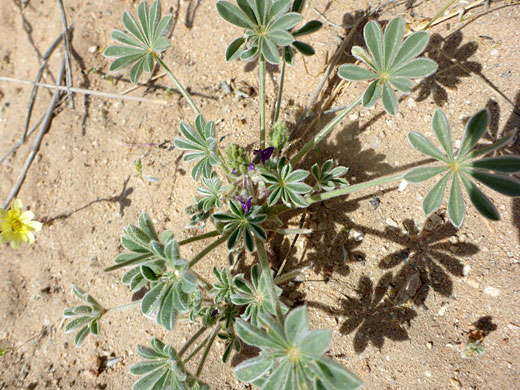
Dark purple flowers with hairy green calyces; lupinus shockleyi, Kelso Dunes Trail, Mojave National Preserve, California
Common name:
Purple desert lupine
Family:
Scientific name:
Lupinus shockleyi
Main flower color:
Range:
The Mojave Desert (not Utah), and some adjoining areas
Height:
Up to 12 inches
Habitat:
Sandy flats and washes, in desert areas; up to 4,500 feet
Leaves:
Divided into 8, 9 or 10 oblanceolate leaflets, up to 1.2 inches long and 0.4 inches wide; on stalks of up to 5 inches
Season:
April to May
Flowers of lupinus shockleyi are deep bluish-purple in color, with a white or pale yellow patch at the center of the banner petal, which is angled back at around 60 degrees. The keel petal is hairless. The calyx has an even covering of quite long, spreading hairs, and the two calyx lips are approximately equal in size, about 0.2 inches in length - slightly shorter than the petals. The inflorescence is a short, vertical cluster occupying the upper 2 to 3 inches of the stem, with spiralled rather than whorled flowers. Each flower is subtended by a short, narrow, persistent bract.
Stems and the undersides of the leaves are covered by soft, canescent hairs; the upper leaf surfaces are hairless. Leaves grow at or near the base, forming a rosette, with ascending stalks. The leaf stalks are three to four times as long as the leaflets. Fruits are short (up to 0.8 inches), broad, ovate pods, with stiff hairs along the margins.
Stems and the undersides of the leaves are covered by soft, canescent hairs; the upper leaf surfaces are hairless. Leaves grow at or near the base, forming a rosette, with ascending stalks. The leaf stalks are three to four times as long as the leaflets. Fruits are short (up to 0.8 inches), broad, ovate pods, with stiff hairs along the margins.
All Contents © Copyright The American Southwest | Comments and Questions | Contribute | Site Map


